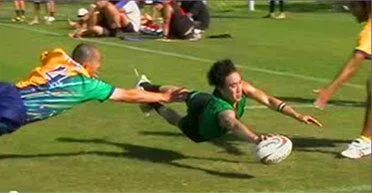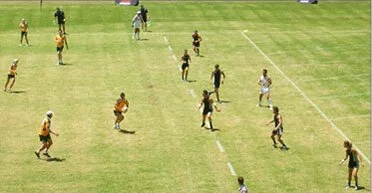|
Touch Rugby to Make Your Players Shine
|
Touch rugby is a simple game that removes the need for most equipment, simplifies the laws by removing lineouts, scrums, rucks and mauls, and, of course, can be played with less fear of injury through tackling. It focuses on running and passing ability. It can allow smaller and lighter players to shine, so is ideal for mixed rugby as well as groups with players of different ages.
The tackle is a one or two handed touch, normally below the waist. From the tackle either a pass is made or the ball is laid back between the legs. The attacking side has a limited number of touch tackles (normally 5 or 6) before the ball is turned over. The defence must retire 5 metres from every tackle.
The worst sort of touch rugby is when there are upwards of 10 players a side spread across the field. There is too much inactivity and lazy play. The best touch rugby engages ALL the players ALL the time, leaving them tired at the end of a session. So split up into smaller groups when player numbers a side approach 10.
There are many variations in touch rugby, not only in format, but also in constraints and opportunities. All are aimed to make the best use of the game. Here are some examples.
3 second touch: The tackled player has 3 seconds to pass the ball once touched. A touched player cannot score a try. A turnover awarded if the ball is not released in time. There is no offside following a turnover.
The game encourages support, passing in the tackle and gives slower forwards the chance to play an active part in the game when taking the ball forward. It makes the players take up better body positions through a potential contact situation.
Double touch: A player can be touched once. If touched a second time, the ball is turned over. A touched player cannot score.
The game promotes support running, but also cover defence. Since players can be tackled twice in quick succession, they learn to move the ball away from danger very quickly.
No mistake touch: This game is better for forwards since it allows them to "rumble up" the pitch. Once touched the player must put the ball through their legs at the point of tackle. Opponents must retire 5 metres. There is a turnover when either the ball is dropped, it goes into touch or following a forward pass. There is no limit to the number of touches a play may take.
The ball is not allowed to be restarted from any situation within 5 metres of the try line. So if a tackle is made in the 5 metre gap in front of the try line, the ball is placed on the 5 metre line. The same goes for a turnover ball.
The main downside of the game is the potential poor body positions it encourages, since there is no need to recycle the ball quickly. However, players soon recognise that better presentation will open more gaps.
In terms of defence, it makes the defence more "honest" closer to the action. The defence either side of the tackle will need to move up quickly to prevent the 5 metre gap being exploited.
Constraints in touch rugby
You can change the game to suit the circumstances. For instance, a high scoring game with two handed touch tackles can be changed to a low scoring game of greater skill by introducing a one handed touch. Try using these constraints to add variety and different pressures to your games, and work your players outside the comfort zone.
Holding tackles: Instead of a touch, let the players hold the ball carrier. This prevents them running beyond the touch point and promotes a more aggressive defence. It is especially useful in 3 second touch where players can be prevented from getting the pass away. Players who are about to be tackled have to get themselves into the right body positions earlier.
Ball on the ground: Normally if the ball goes to ground in touch rugby, a turnover is declared to avoid contact. This rule can be relaxed on occasions, especially with more experienced and older players, so players have to field the ball quickly from the floor.
One hand or two hand touch: A one handed touch is better when the field is wide and the players few. A two handed touch means harder work for the defence, so the players have to be in a better body position to make the tackle.
And then there is FIJI Touch!!: Just come and join in to find out what that is!! We play that when there is even ore concentration on FITNESS and SPEED and RESPONSE TIME!
|
| |
|

